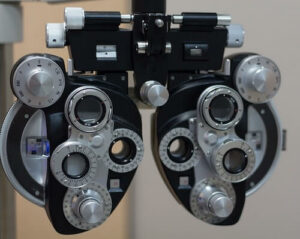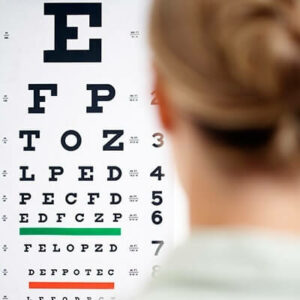Why do we have annual eye exam recalls? Why not every 2 or 3 years? It is the Beartooth Vision Center policy to remind our patients to come in for their eye examinations on a yearly schedule. This ensures that our patient’s eyes are healthy, as many significant eye conditions have no symptoms. Because a poor fitting contact lens can be sight-threatening and because we want our patients to be aware of the newest lens technology, we also see our contact lens patients each year. After their annual eye exam the vast majority of all of our patients see better – sometimes much better – with their updated glasses and contact lens prescriptions. We believe it is important that our patients have the opportunity to improve their visual clarity once a year. It can change your life. Wouldn’t it be nice to have the option to hear better, to improve your sense of taste or smell, or to heighten your sense of touch once a year? It is truly wonderful that it is possible to do this so easily with your sight – and all it takes is scheduling an annual eye examination.
Yearly Eye Health Exams
 While a comprehensive yearly adult eye and vision examination may include the following tests, individual patient signs and symptoms, along with the professional judgment of our doctors, may significantly influence the testing done.
While a comprehensive yearly adult eye and vision examination may include the following tests, individual patient signs and symptoms, along with the professional judgment of our doctors, may significantly influence the testing done.
The patient history helps to determine any symptoms the patient is experiencing, the presence of any general health problems, medications taken and occupational and environmental conditions that may be affecting vision. We will ask about any eye or vision problems you may be having and about your overall health. We will also ask about any previous eye or health conditions for you and your family members.
Depending on the results of the annual eye examination, additional testing may be required. The doctor will discuss with you the nature of any visual or eye health problems found and explain available treatment options. In some cases, referral for consultation or treatment by an eye specialist may be indicated, but this is rare. With the instruments we have in our office, many eye conditions can be treated and monitored here at Beartooth Vision Center.
If you have questions regarding any eye or vision conditions diagnosed, or treatment recommended, don’t hesitate to ask. We are glad to help you to understand the status of your eyes and vision and why we do what we do in an eye examination.
A patient history helps to determine any symptoms the patient is experiencing, the presence of any general health problems, medications taken and occupational and environmental conditions that may be affecting vision. We ask about any eye or vision problems, your overall health, as well as any previous eye or health conditions for you and your family members.
 Snellen acuity charts are used to measure the sharpness of your vision. Visual acuity measurements evaluate how clearly each eye is seeing. As part of the testing, you are asked to read letters on distance and near reading charts. In the world of visual acuity, the smaller the better. The results of visual acuity testing are written as ratios such as 20/40. For distance vision, the top number in the fraction is the standard twenty foot test distance. The bottom number is the smallest letter size you were able to read at the test distance. In an exam room a bit shorter than 20 feet, the chart letter sizes are calibrated and adjusted for the exam room length. A person with 20/40 visual acuity would have to get within 20 feet of a letter that can be seen at 40 feet by a person with 20/20 vision. A person with 20/20 vision can see at 400 feet what a 20/400 seeing person can only see when they are 20 feet away. In other words, the 20/20 person sees things clearly 1/20 the size of the 20/400 person. They aren’t 20 times better as a person, but they do see 20 times better. Sometimes life ain’t fair.
Snellen acuity charts are used to measure the sharpness of your vision. Visual acuity measurements evaluate how clearly each eye is seeing. As part of the testing, you are asked to read letters on distance and near reading charts. In the world of visual acuity, the smaller the better. The results of visual acuity testing are written as ratios such as 20/40. For distance vision, the top number in the fraction is the standard twenty foot test distance. The bottom number is the smallest letter size you were able to read at the test distance. In an exam room a bit shorter than 20 feet, the chart letter sizes are calibrated and adjusted for the exam room length. A person with 20/40 visual acuity would have to get within 20 feet of a letter that can be seen at 40 feet by a person with 20/20 vision. A person with 20/20 vision can see at 400 feet what a 20/400 seeing person can only see when they are 20 feet away. In other words, the 20/20 person sees things clearly 1/20 the size of the 20/400 person. They aren’t 20 times better as a person, but they do see 20 times better. Sometimes life ain’t fair.
These tests include evaluation of specific aspects of visual function and eye health such as depth perception, color vision, eye muscle movements, peripheral or side vision screening, and the way pupils respond to light.
Keratometry is the numeric measure of the curvature of the cornea. This tissue is the clear outer surface of the eye. This measurement is particularly critical in determining the proper fit for contact lenses. While similar, the topography is a mapping of the contours of a large portion of the cornea. It is very much like a topographic map, but the lines indicate differences in curvature instead of elevation. The corneal topographer is essential to understanding the influence of the cornea on your vision and is also used to diagnose degenerative cornea conditions.
Refraction is the process of finalizing the glasses prescription with a phoropter and sometimes a retinoscope and trial frame. The refraction determines the appropriate lens power needed to compensate for any refractive error (nearsightedness, farsightedness, or astigmatism). Using the phoropter, the doctor places a series of lenses in front of your eyes and measures how they focus light using a hand held lighted instrument called a retinoscope. The doctor will also use the data from a sophisticated device called the OPD III Wavescan that automatically evaluates the refractive error of the eye. The final prescription is ultimately arrived at by the patient’s responses to the lenses that allow the clearest vision. For patients with bifocals glasses, proper bifocal prescription is arrived at in “free space”, allowing the patient to hold reading material at their normal working distance. To base the bifocal power strictly on the patient’s age is often not sufficient. Generally, a person who hold things closer needs more bifocal reading power than another person who naturally holds things such as books further away. For example, a 45 year old patient with short arms can require a stronger bifocal power than a 55 year old with a long working distance.
This testing is usually done without the use of eye drops. This allows the eyes to respond under normal seeing conditions and gives the most accurate glasses prescription. In some cases, however, such as for younger or non-verbal patients, or when some of the eye’s focusing power may be influencing the accuracy of the glasses prescription, eye drops are used. The drops temporarily keep the eyes from changing focus while the refraction is being done.
Assessment of accommodation (focusing), ocular motility (movement) and binocular (stereo) vision help to determine how well the eyes focus, move and work together. In order to obtain a clear, single image of what is being viewed, the eyes must effectively change focus, move and work in unison. This testing identifies problems that keep your eyes from focusing effectively or make using both eyes together difficult. We also test for color vision.
The outside of the eye and the front portion of the internal eye are examined with a slit lamp biomicroscope. The cornea, iris, pupil, and lens are all observed with the bright illumination and high magnification this instrument provides. The pressure inside the eye is also measured using this instrument. Elevated pressure in the eye is a risk factor for a treatable condition called glaucoma which causes irreversible damage to the optic nerve of the eye.
The health of the rear portion of the inside of the eye, including the retina, the optic nerve, the macula, and the retinal blood vessels are all evaluated using the Optomap Retinal Exam or with dilating drops with hand held lenses, or sometimes both. The Optomap takes a 200 degree panoramic digital laser scan of the internal eye in 1/4 second without dilation. In addition to the digital perspective it offers, the Optomap provides a powerful tool for comparison of retinal structure changes over the years – far better than old style hand written record notes. For these reasons, we highly recommend the Optomap for all of our patients for their eye exams each year. In this case, a digital picture truly has more value than a thousand words.
Depending on the results of the annual eye examination, additional testing may be required. The doctor will discuss with you the nature of any visual or eye health problems found and explain available treatment options. In some cases, referral for consultation or treatment by an eye specialist may be indicated, but this is rare. With the instruments we have in our office, many eye conditions can be treated and monitored here at Beartooth Vision Center.
If you have questions regarding any eye or vision conditions diagnosed, or treatment recommended, don’t hesitate to ask. We are glad to help you to understand the status of your eyes and vision.
BVC provides…
- Annual eye examinations
- Thorough, relaxed, and personal care
- Optomap digital retinal exams. Excellent baseline digital pictures of the inside of your eye for monitoring future changes.
- Different types of contact lens fittings, including specialty contacts and amazingly comfortable daily contact lenses
- Glaucoma diagnosis and treatment
- Superficial foreign body removal from the eye as well as treatment of corneal abrasions
- Treatment of eye infections and allergies
- Removal of in-turned eyelashes
- Dry eye treatment, including punctal plugs
- Diagnosis and tracking of dry macular degeneration and treatment referral for the wet form
- Monitoring for the presence of diabetic and hypertensive retinopathy
- Diagnosis of retinal pathology with appropriate specialist referral and consultation
- Peripheral vision testing, including for eyelid surgery referral
- Cataract surgery referral and co-management
- Refractive surgery (LASIK and PRK) co-management
- A selection of 1,200 frames in one of Billings’ most attractive and friendly eyewear centers
- High quality glasses lenses that are made here in Montana
- CareCredit and many insurance plans are accepted
- Free adjustments and minor repairs for eyeglasses
- The best glasses cleaner solution we’ve ever seen
- Fresh brewed coffee and the Wall Street Journal







